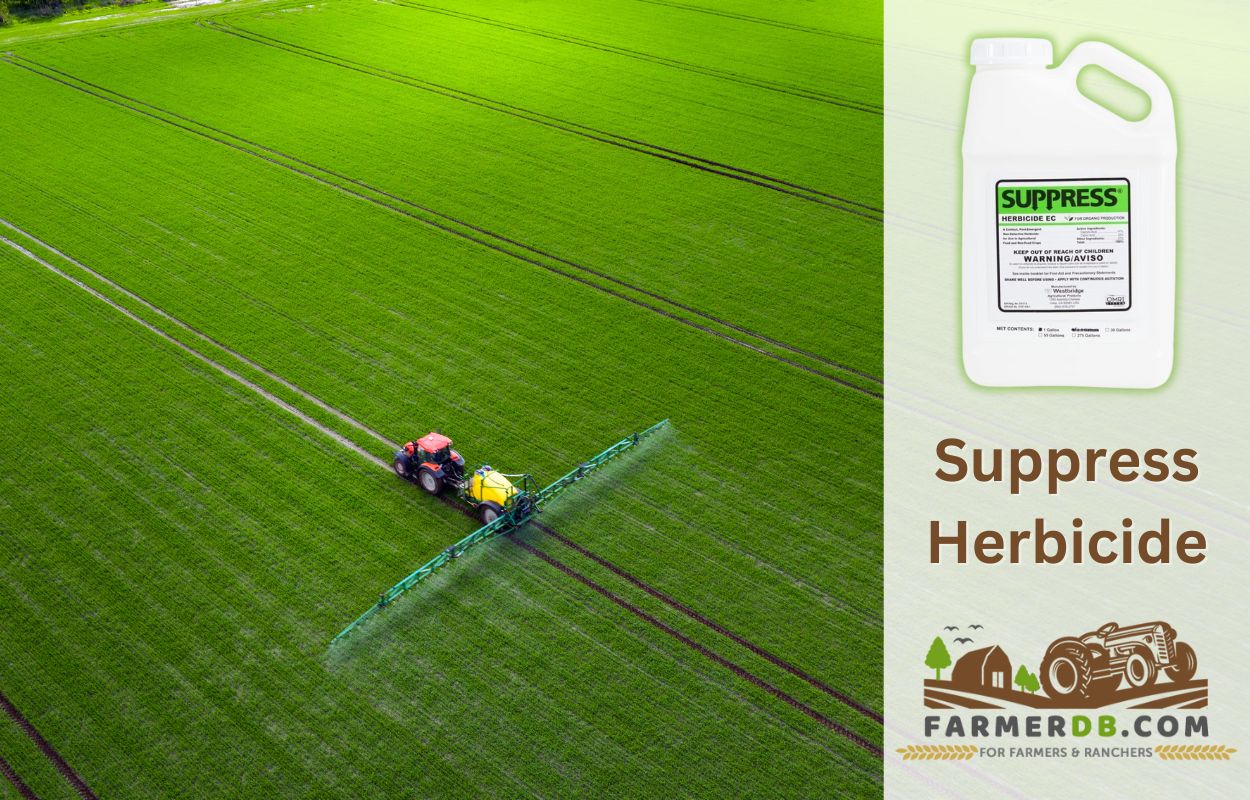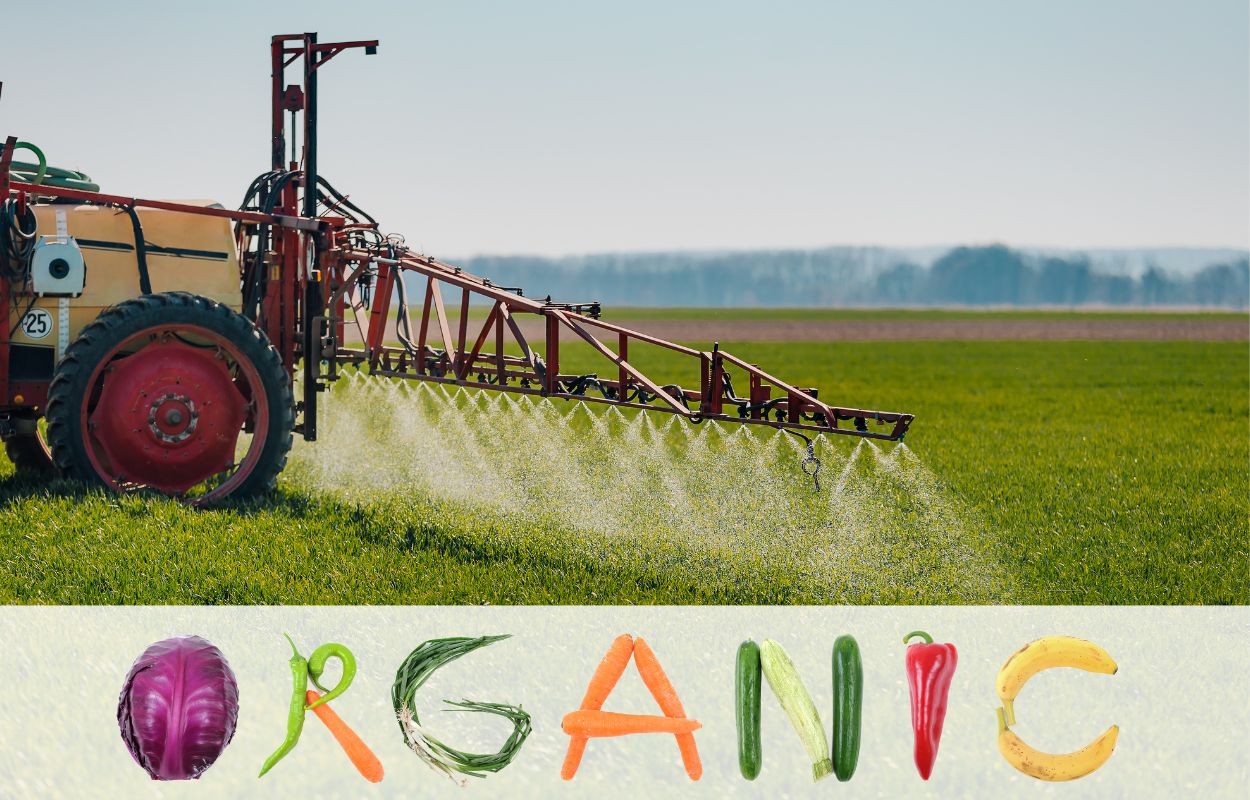
Suppress herbicide is a new product that has recently entered the market, with the goal of revolutionizing weed control in agriculture. This herbicide has a unique formulation and demonstrates a strong commitment to organic practices.
The distinctive formulation of this organic herbicide sets it apart, particularly for farmers who prioritize organic methods and search for effective alternatives to conventional non-selective herbicides. It helps farmers in managing unwanted plant growth while adhering to sustainable principles.
Find out what its active ingredients are, how to use it, when to use it, how to apply it, and take a step towards sustainable and organic farming with Suppress Herbicide.
Contents
What is Suppress Herbicide?
Suppress herbicide is a non-selective, post-emergent, contact herbicide registered for use in organic production, as well as in agricultural food and non-food crops, for the control or elimination of unwanted plants.
The active ingredient
The active ingredients in Suppress herbicide are Caprylic acid (47%) and Capric acid (32%).
Both of these active ingredients belong to the group of saturated fatty acids and are classified as medium-chain fatty acids.
Derived from coconut oil and palm seed kernel, caprylic acid serves as a contact, post-emergent non-selective herbicide when mixed with capric acid.
How does it work
The Suppress herbicide works by rapidly damaging plants upon contact. It primarily targets the leaves, inhibiting the weed’s ability to photosynthesize and impeding its development.
This mode of action is commonly referred to as desiccation.
Where to use it
You can use Suppress herbicide on food crops such as berries, rice, cereal grains, and leafy greens, as well as non-food crops like turf, flowers, trees, and non-agricultural and industrial sites, including golf courses and landscapes.
Table 1, 2, and 3 provides an overview of the specific crops where Suppress herbicide can be used.
| Crop Type | Crop Names |
|---|---|
| Berries | Blackberries, Blueberries, Boysenberries, Cranberries, Dewberries, Loganberries, Raspberries |
| Brassicas (Cole) | Broccoli, Brussels Sprouts, Cabbage, Cauliflower, Collards, Kale, Mustard Greens |
| Bulb Vegetables | Garlic, Leaks, Onions, Shallots |
| Cereal Grains | Barley, Corn, Oats, Rye, Sorghum (Milo), Wheat |
| Citrus | Grapefruits, Lemons, Limes, Oranges, Mandarins |
| Cucurbit Vegetables | Cantaloupes, Cucumbers, Gourds, Muskmelons, Pumpkins, Squash, Watermelons |
| Field Crops | Alfalfa, Canola, Cereal Grains, Corn, Cotton, Sorghum, Soybeans, Sweet Corn |
| Fruiting Vegetables | Eggplant, Peppers (All Varieties), Tomatillos, Tomatoes |
| Herbs and Spices | Anise, Basil, Chive, Dill, Fennel, Oregano |
| Grapes | Raisin, Table Grapes, Wine Grapes |
| Leafy Greens | Arugula, Celery, Lettuce, Spinach |
| Legumes | Beans, Garbanzo, Lentils, Peas |
| Tree Nuts | Almonds, Cashews, Hazelnuts (Filberts), Pecans, Pistachios, Walnuts |
| Pome Fruit | Apples, Crabapples, Pears, Quince |
| Rice | Do not apply when fields are flooded. |
| Stone Fruit | Apricots, Cherries, Nectarines, Peaches, Plums, Prunes |
| Strawberries | June-bearing, Everbearing, and Day-neutral |
| Root & Tuber Vegetables | Beets, Carrots, Potatoes, Potato Seed, Radishes, Sweet Potatoes |
| Tropical Fruits | Guavas, Mangos, Kiwi Fruit, Bananas |
| Miscellaneous Crops | Artichokes, Asparagus, Avocados, Olives, Persimmons, Pomegranates |
| Category | Crop Types |
|---|---|
| Turf | Flowers, Bedding Plants, Flowers and Ornamentals, Turf Grass (Maintenance, Sod or Seed Production) |
| Landscape | Trees and Shrubs Christmas Trees, Forest and Commercial Trees, Landscape Trees, Nursery Trees or Shrubs |
| Greenhouse and Nurseries | All Crops, Plants |
| Fallow Land | Forages and Pastures, Uncultivated Land |
| Sites |
|---|
| Parks |
| Gold courses |
| Ornamentals |
| Landscapes |
| Interiorscapes |
| Non-crop areas |
| Around building structures |
Suppress herbicide is effective for controlling unwanted growth, including suckers, on woody trees, vines, and brambles.
The treatment should be applied exclusively to the undesired vegetative parts mentioned, such as basal suckers, foliage, and excessive cane.
When to apply Suppress Herbicide
Suppress herbicide should be applied in late spring or early summer when the weeds have emerged and are actively growing. Applying it during this time will ensure optimal results.
What does Suppress herbicide kill?
Suppress herbicide controls and eliminates annual and perennial broadleaf weeds and grasses.
| Grassy Lawn Weeds | Broadleaf Lawn Weeds | ||||||||||||||||||||||||||||||||||||||||||||||||||||||
|---|---|---|---|---|---|---|---|---|---|---|---|---|---|---|---|---|---|---|---|---|---|---|---|---|---|---|---|---|---|---|---|---|---|---|---|---|---|---|---|---|---|---|---|---|---|---|---|---|---|---|---|---|---|---|---|
|
|
Suppress Herbicide Mix Ratio
You can mix 4 fl. oz. of Suppress herbicide per gallon of water for a 3% solution, 8 fl. oz. per gallon of water for a 6% solution, and 12 fl. oz. for a 9% solution.
The herbicide label also states that you can adjust the Suppress herbicide mix ratio based on the growth stage of the weeds.
You can use the lower range for young, succulent, and actively growing seeds, and the higher rate for weeds exceeding six inches in height.
Also, you can utilize the highest rate for perennial weeds that have hardened.
Table 5 offers you more details about Suppress herbicide mix ratio.
| Desired Volume of Spray Solution (gallons of water) |
Amount of SUPPRESS® Herbicide EC per Volume of Water (Volume/Volume) |
||
|---|---|---|---|
| 3% Solution | 6% Solution | 9% Solution | |
| 1 | 4 fl oz | 8 fl oz | 12 fl oz |
| 3 | 12 fl oz | 24 fl oz | 36 fl oz |
| 25 | 96 fl oz | 1.5 gal | 2.25 gal |
| 50 | 1.5 gal | 3 gal | 4.5 gal |
| 70 | 2.1 gal | 4.2 gal | 6.3 gal |
| 100 | 3 gal | 6 gal | 9 gal |
Suppress Herbicide Mixing Instructions
Mixing Suppress herbicide is an easy process when using this type of herbicide. However, it is necessary to always follow the label guidelines and respect the provided instructions and rates.
When mixing Suppress herbicide, it is recommended to follow these steps:
- Prepare the appropriate container nearby and ensure that you have the correct personal protective equipment (PPE) for handling herbicides. The herbicide label specifies the necessary protective gear, including protective eyewear, coveralls over short-sleeved shirt and short pants, shoes, socks, and chemical-resistant gloves.
- Once you have completed the first step, fill the sprayer tank with half of the recommended water. For instance, if you aim to obtain 1 gallon, fill the tank with just half of that amount.
- Add the specified amount of Suppress herbicide as recommended on the label.
- After adding the herbicide, fill the tank with the remaining half of the required water quantity.
- Stir and agitate the solution thoroughly until everything is uniformly dissolved.
- Ensure that you use the final solution within 4 hours of mixing.
It is not necessary to use a surfactant with Suppress herbicide. In fact, the label does not recommend tank mixing this herbicide with silicone-based surfactants or non-ionic surfactants.
If you intend to mix Suppress herbicide with other products, it is advisable to conduct a jar test to check for compatibility between them.
If the jar test has positive results, meaning that combining the two products does not result in a precipitate, then you can proceed to use the final solution. Always remember to review the labels of both products for any specific instructions.
Avoid tank mixing with products that explicitly prohibit such mixing. It is essential to carefully examine the labels of all the products you plan to use to ensure compatibility and adherence to guidelines.
How to apply it
Applying Suppress Herbicide in areas damaged by weeds is surprisingly easy and straightforward.

Following these steps will know exactly how to apply Suppress herbicide correctly:
- Ensure that the timing is appropriate. As a post-emergent herbicide, it should be applied when the weeds are actively growing.
- Check the weather conditions:
– Avoid applying the herbicide in strong winds.
– Ensure that the temperature does not exceed 85°F (30°C).
– Check the weather forecast to ensure no rain is expected within 4 hours of spraying. - Wear the proper personal protective equipment (PPE) for herbicide application.
- Mix the herbicide with the appropriate quantity of water following the provided instructions.
- Prepare your applicator. Suppress herbicide is a non-volatile, emulsifiable concentrate that can be easily applied using ground equipment, such as boom sprays. Avoid aerial application.
- Apply the solution directly to the weed. Ensure that the entire weed is covered with the spray solution, as this herbicide acts on contact and does not translocate within the plant. If any part of the weed is left untreated, it will have zero effect.
Be cautious and do not use this herbicide on rice fields when they are submerged in water or flooded. The label of this herbicide advises against applying it to wet weeds from dew, rain, or water. - After completing the application in the desired area, clean your equipment and PPE properly.
Suppress Herbicide Restriction for Use
For land-based applications: Avoid direct application to water bodies, areas with surface water, or intertidal zones below the average high water mark.
Prevent the application or drift of this product onto flowering crops or weeds while honey bees are actively foraging in the treated area. To provide optimal protection for honey bees, avoid applying during early morning and late afternoon hours.
Suppress Herbicide Alternative
An alternative to Suppress Herbicide is Homeplate herbicide.


